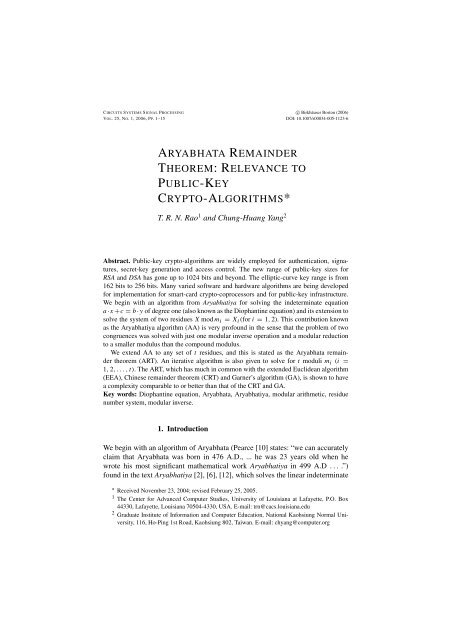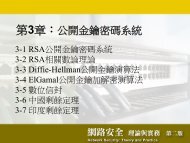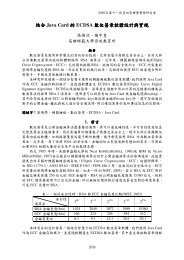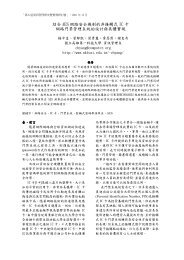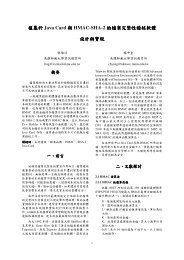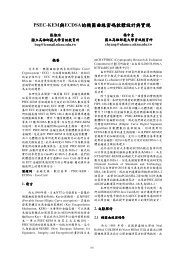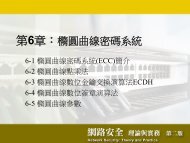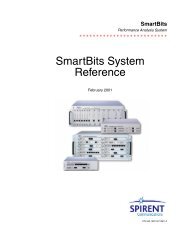aryabhata remainder theorem: relevance to public-key crypto ...
aryabhata remainder theorem: relevance to public-key crypto ...
aryabhata remainder theorem: relevance to public-key crypto ...
Create successful ePaper yourself
Turn your PDF publications into a flip-book with our unique Google optimized e-Paper software.
CIRCUITS SYSTEMS SIGNAL PROCESSING c○ Birkhäuser Bos<strong>to</strong>n (2006)<br />
VOL. 25, NO. 1, 2006, PP. 1–15 DOI: 10.1007/s00034-005-1123-6<br />
ARYABHATA REMAINDER<br />
THEOREM: RELEVANCE TO<br />
PUBLIC-KEY<br />
CRYPTO-ALGORITHMS*<br />
T. R. N. Rao 1 and Chung-Huang Yang 2<br />
Abstract. Public-<strong>key</strong> cryp<strong>to</strong>-algorithms are widely employed for authentication, signatures,<br />
secret-<strong>key</strong> generation and access control. The new range of <strong>public</strong>-<strong>key</strong> sizes for<br />
RSA and DSA has gone up <strong>to</strong> 1024 bits and beyond. The elliptic-curve <strong>key</strong> range is from<br />
162 bits <strong>to</strong> 256 bits. Many varied software and hardware algorithms are being developed<br />
for implementation for smart-card cryp<strong>to</strong>-coprocessors and for <strong>public</strong>-<strong>key</strong> infrastructure.<br />
We begin with an algorithm from Aryabhatiya for solving the indeterminate equation<br />
a ·x +c = b· y of degree one (also known as the Diophantine equation) and its extension <strong>to</strong><br />
solve the system of two residues X mod mi = Xi (for i = 1, 2). This contribution known<br />
as the Aryabhatiya algorithm (AA) is very profound in the sense that the problem of two<br />
congruences was solved with just one modular inverse operation and a modular reduction<br />
<strong>to</strong> a smaller modulus than the compound modulus.<br />
We extend AA <strong>to</strong> any set of t residues, and this is stated as the Aryabhata <strong>remainder</strong><br />
<strong>theorem</strong> (ART). An iterative algorithm is also given <strong>to</strong> solve for t moduli mi (i =<br />
1, 2,...,t). The ART, which has much in common with the extended Euclidean algorithm<br />
(EEA), Chinese <strong>remainder</strong> <strong>theorem</strong> (CRT) and Garner’s algorithm (GA), is shown <strong>to</strong> have<br />
a complexity comparable <strong>to</strong> or better than that of the CRT and GA.<br />
Key words: Diophantine equation, Aryabhata, Aryabhatiya, modular arithmetic, residue<br />
number system, modular inverse.<br />
1. Introduction<br />
We begin with an algorithm of Aryabhata (Pearce [10] states: “we can accurately<br />
claim that Aryabhata was born in 476 A.D., ... he was 23 years old when he<br />
wrote his most significant mathematical work Aryabhatiya in 499 A.D ... .”)<br />
found in the text Aryabhatiya [2], [6], [12], which solves the linear indeterminate<br />
∗ Received November 23, 2004; revised February 25, 2005.<br />
1 The Center for Advanced Computer Studies, University of Louisiana at Lafayette, P.O. Box<br />
44330, Lafayette, Louisiana 70504-4330, USA. E-mail: trn@cacs.louisiana.edu<br />
2 Graduate Institute of Information and Computer Education, National Kaohsiung Normal University,<br />
116, Ho-Ping 1st Road, Kaohsiung 802, Taiwan. E-mail: chyang@computer.org
2 RAO AND YANG<br />
equation a · x + c = b · y, for positive integers a, b, and c (sometimes called a<br />
Diophantine equation). This algorithm also solves for X, given the pair of residues<br />
X mod mi = xi (for i = 1, 2). There is some underlying principle of simplicity<br />
in this solution, which has been found <strong>to</strong> be applicable <strong>to</strong> solving the general case<br />
of n residues in an iterative manner, requiring as few inverse operations as any<br />
we know of <strong>to</strong>day and also without requiring a final modular reduction operation.<br />
This leads us <strong>to</strong> state this idea as the Aryabhata <strong>remainder</strong> <strong>theorem</strong> (ART). The<br />
ART algorithm presented here is comparable and in some ways more efficient<br />
than the CRT algorithm of Gauss [4], the original Garner algorithm [3], and the<br />
later version of GA given in [8], [9].<br />
1.1. Aryabhata algorithm (AA)<br />
In the field of pure mathematics, one of the most significant contributions of<br />
Aryabhata is his solution <strong>to</strong> the indeterminate equation a · x + c = b · y. We<br />
copy here the example and discussion given by Pearce [10] from Aryabhatiya [2],<br />
[12]<br />
Example 1.<br />
137 · x + 10 = 60 · y (1)<br />
60)137(2 (60 divides in<strong>to</strong> 137 twice with <strong>remainder</strong> 17, etc)<br />
120<br />
-----------<br />
17)60 (3<br />
51<br />
------------<br />
9)17 (1<br />
9<br />
----------<br />
8<br />
9 (1<br />
8<br />
----------<br />
1<br />
⎛ ⎞<br />
2<br />
⎜<br />
The column of quotients known as valli (Vertical line) is constructed: ⎜3<br />
⎟<br />
⎝1⎠<br />
1<br />
Remark. This method was called kuttaka, which literally means “pulverizer,” on<br />
account of the process of continued division that is carried out <strong>to</strong> obtain successively<br />
smaller <strong>remainder</strong>s. This is traditionally called a Euclidean algorithm. This
ARYABHATA REMAINDER THEOREM 3<br />
process in traditional textbook format of n equations is written as follows:<br />
a = b · q1 + r1<br />
b = r1 · q2 + r2<br />
⎫<br />
⎪⎬<br />
.<br />
⎪⎭<br />
rn−2 = rn−1 · qn + rn<br />
In some books [1], this is given as a continued fraction version of Euclid’s algorithm.<br />
The number of quotients, omitting the first one, is 3, which is odd. Hence,<br />
we choose a multiplier k such that on multiplication by the last residue, 1 (in the<br />
dashed rectangle), and subtracting 10 from the product the result is divisible by the<br />
penultimate <strong>remainder</strong>, 8 (in the dashed circle). If the number of quotients, after<br />
omitting the first one, is even, then adding 10 is required instead of subtracting.<br />
We have 1 · 18 − 10 = 1 · 8. Then we can form the following table:<br />
2 2 2 2 297<br />
3 3 3 130 130<br />
1 1 37 37<br />
1 19 19<br />
k = 18 18<br />
1<br />
This can be explained as follows.<br />
The number 18, and the number above it in the first column, multiplied and<br />
added <strong>to</strong> the number below it, gives the last but one number in the second column.<br />
Thus, 18·1+1 = 19. The same process is applied <strong>to</strong> the second column, giving the<br />
third column result: 19 · 1 + 18 = 37. Similarly, 37 · 3 + 19 = 130, 130 · 2 + 37 =<br />
297. Then x = 130, y = 297 are solutions of the given equation. Noting that<br />
297(mod 137) = 23 and 130(mod 60) = 10, we get x = 10 and y = 23 as simple<br />
solutions. Thus, we have 137 · 10 + 10 = 60 · 23 as a solution for equation (1).<br />
1.2. Improved Aryabhata algorithm (IAA)<br />
We show how <strong>to</strong> simplify considerably the above procedure. First replace c with<br />
d = gcd(a, b) = gcd (137, 60) = 1 in equation (1) <strong>to</strong> obtain the following.<br />
Example 2.<br />
137 · x + 1 = 60 · y (3)<br />
We obtain qi as before. Form a table with the first column as the iteration variable<br />
i, and the valli of qi as the second column. The third column of Si is obtained<br />
from the bot<strong>to</strong>m up in a similar manner as in Example 1. We start with S5 = 1,<br />
S4 = q4 as initial values and use the recursion formula:<br />
Si = qi · Si+1 + Si+2<br />
(2)<br />
(4)
4 RAO AND YANG<br />
i qi Si<br />
1 2 16<br />
2 3 7<br />
3 1 2<br />
4 1 1<br />
5 – 1<br />
We compute the Si’s from the bot<strong>to</strong>m up.<br />
S3 = q3 · S4 + S5 = 1 · 1 + 1 = 2<br />
S2 = q2 · S3 + S4 = 3 · 2 + 1 = 7<br />
S1 = q1 · S2 + S3 = 2 · 7 + 2 = 16<br />
We note the number of quotients n = 4, and gcd (137, 60) = d = 1. We give<br />
the answer <strong>to</strong> equation (3) as 137 · S2 + (−1) n d = 60 · S1. Thus, we have<br />
137 · 7 + 1 = 60 · 16. To solve equation (1), we multiply the solution for equation<br />
(3) by 10 <strong>to</strong> get 137 · 70 + 10 = 60 · 160. By taking out 137 · 60 from both sides,<br />
we get the simple solution 137 · 10 + 10 = 60 · 23.<br />
Improved IAA for solving a · x + d = b · y<br />
INPUT: a and b are positive integers and d = gcd(a, b)<br />
1. i ← 1, r−1 = a, r0 = b<br />
2. while (ri ← ri−2 mod ri−1 = 0) do the following:<br />
qi ← quotient(ri−2/ri−1)<br />
i ← i + 1<br />
3. n ← i − 1, Sn+1 = 1, Sn = qn<br />
4. For i from n − 2 down <strong>to</strong> 1 do the following:<br />
Si = qi · Si+1 + Si+2<br />
OUTPUT: x =[(−1) n · S2] mod b, y =[(−1) n · S1] mod a<br />
Definition 1. We define the value for S1 <strong>to</strong> be optimal if 0 < S1 < a, and S2 <strong>to</strong><br />
be optimal if 0 < S2 < b. Any solution <strong>to</strong> a · x + c = b · y is said <strong>to</strong> be optimal<br />
if 0 < x < b or 0 < y < a.<br />
Remark. Lemma 1, given later, shows that the IAA obtains optimal values for<br />
S1 and S2.<br />
The <strong>relevance</strong> of the solution 137·7+1 = 60·16 for us is that 137 −1 mod 60 =<br />
−7 mod 60 = 53 and 60 −1 mod 137 = 16. Thus, we get both inverses, a −1 mod b<br />
and b −1 mod a, by this method. Also, these lead us <strong>to</strong> the solution <strong>to</strong> the problem<br />
of two residues, as shown in Section 2.<br />
The theory behind the results of the preceding two examples can be put in the<br />
form of two lemmas and a <strong>theorem</strong> as follows.
ARYABHATA REMAINDER THEOREM 5<br />
Lemma 1. Let a, b, c, qi,ri, Si, d, and n be as defined in the previous examples.<br />
For a · x + d = b · y, the IAA yields optimal values for S1 and S2, i.e., 0 < S1 < a<br />
and 0 < S2 < b.<br />
Lemma 2. The optimal solution <strong>to</strong> a · x + d = b · y is given by<br />
x =[(−1) n · S2] mod b,<br />
y =[(−1) n · S1] mod a.<br />
Theorem 1. An optimal solution <strong>to</strong> a · x + c = b · y is given by<br />
x =[(−1) n · S2(c/d)] mod b<br />
y = (−1) n · S1(c/d) + ka, where k ={x −[(−1) n · S2(c/d)]/b.<br />
The proofs of these lemmas and the <strong>theorem</strong> are simple and are not required <strong>to</strong><br />
understand what follows. Therefore, we conveniently move them <strong>to</strong> the Appendix.<br />
For a clearer understanding, a few examples are also provided there.<br />
2. The problem of two residues<br />
Consider X mod 60 = 0andX mod 137 = 10. Clearly, X = 60y for some y and<br />
also X = 137x + 10 for some x. That means we solve 137 · x + 10 = 60 · y,<br />
which we did in the previous section. Thus, X = 60 · 23 = 1380. Let us now<br />
modify the problem slightly by adding a 5 <strong>to</strong> both of the residues. Then we have<br />
X mod 60 = 5andX mod 137 = 15.<br />
The answer here is just <strong>to</strong> add 5 <strong>to</strong> the previous solution and we get X = 1385.<br />
This is the very important underlying principle in Aryabhata’s solution <strong>to</strong> the<br />
problem of two residues: we solve the problem of two residues by first solving<br />
the Diophantine equation a · x + c = b · y and then adding a constant. Solving the<br />
equation amounts <strong>to</strong> finding the modular inverse of b mod a and then a modular<br />
multiplication with c mod a. This is a profound and significant contribution of<br />
Aryabhata, which should be recognized by the cryp<strong>to</strong>logy community. Its extension<br />
for the t-moduli we present here will also be of great importance due <strong>to</strong> the<br />
PCKS # 1 v2.1 of the RSA cryp<strong>to</strong>graphic standard [11], which discusses modulus<br />
n of 2048 bits, a composite of four primes each of 512 bits. In this context,<br />
every contribution in residue operations and number conversions will become<br />
important both now and in the future. This was called the Aryabhata algorithm<br />
(AA) by Kak [6]. That paper also contains a detailed his<strong>to</strong>rical presentation on the<br />
system of multiple residues in India and the work of Sun Tzu and others in China.<br />
Kak also discusses how the Aryabhata algorithm was used <strong>to</strong> solve problems in<br />
astronomy in India. Here we develop the solution as a formal <strong>theorem</strong> and call<br />
it the Aryabhata reminder <strong>theorem</strong> (ART) as a tribute <strong>to</strong> perhaps the greatest<br />
mathematician and astronomer of the classical period (the fifth century <strong>to</strong> the<br />
twelfth century A.D.).
6 RAO AND YANG<br />
2.1. Aryabhata <strong>remainder</strong> <strong>theorem</strong> (ART)<br />
Theorem (ART). Let m1 and m2 be relatively prime moduli and M = m1m2.<br />
Given X mod m1 = x1, X mod m2 = x2, X has a unique solution in Z M given by<br />
X = ART(x1, x2; m1, m2; M)<br />
= ART(0, c; m1, m2; M) + x1, where c = (x2 − x1) mod m2<br />
= A + x1, where A = m1[(c · m −1<br />
1 ) mod m2].<br />
Proof. First we show that X = A + x1 ∈ Z M. Because A = m1 · b for some<br />
b ∈ Zm2 , A must be less than or equal <strong>to</strong> m1(m2 − 1). Because x1 < m1, A + x1<br />
must be less than M = m1m2, and therefore X ∈ Z M. Now consider (A +<br />
x1) mod m1. Because A is a multiple of m1, wehave(A + x1) mod m1 = x1.<br />
Because A mod m2 = c due <strong>to</strong> the cancellation of the terms m1 and m −1<br />
1 ,wehave<br />
(A + x1) mod m2 = c + x1 = x2. Thus, A + x1 = X satisfies the two congruences<br />
as required and is a solution in Z M. It is easy <strong>to</strong> show that A + x1 is a unique<br />
solution in Z M. IfY ∈ Z M is another solution, then (X − Y ) mod mi = 0, for<br />
i = 1, 2, and (X − Y ) mod M = 0. Thus, X = Y . ✷<br />
A formal extension of ART <strong>to</strong> any number of moduli is rather straightforward and<br />
is given in Section 5. Here we illustrate by an example.<br />
Example 3. Let X mod 3 = x1 = 1, X mod 4 = x2 = 3, and X mod 5 = x3 = 3.<br />
Then X = ART(1, 3, 3; 3, 4, 5; 60).<br />
Step 1.<br />
Step 2.<br />
X ′ = X mod 12 = ART(1, 3; 3, 4; 12)<br />
= ART(0, 2; 3, 4; 12) + 1<br />
= 3[(2 · 3 −1 ) mod 4]+1<br />
= 3 · 2 + 1 = 7<br />
X = ART(7, 3; 12, 5; 60)<br />
= ART(0,(3 − 7) mod 5; 12, 5; 60) + 7<br />
= ART(0, 1; 12, 5; 60) + 7<br />
= 12[(1 · 12 −1 ) mod 5]+7<br />
= 12 · 3 + 7 = 43<br />
3. Multiplicative inverse<br />
Given positive pairwise prime integers a and b, it is very often necessary <strong>to</strong> find<br />
a −1 mod b. That is, <strong>to</strong> find x ∈ Zb such that a · x mod b = 1. In RSA, the private
ARYABHATA REMAINDER THEOREM 7<br />
<strong>key</strong> d is generated by finding the inverse of <strong>public</strong>-<strong>key</strong> e mod ∅(n), where ∅(n) =<br />
(p − 1)(q − 1). The extended Euclidean algorithm (EEA) [8], [9] given below<br />
obtains a · x + b · y = 1, for given a and b. Finding the multiplicative inverse is<br />
illustrated in Example (4).<br />
3.1. Extended Euclidean algorithm (EEA)<br />
The EEA is available in most texts [8], [9]. The simpler version of the Euclidean<br />
algorithm from [7] will illustrate the principle as well.<br />
Example 4. Let a = 137 and b = 60.<br />
i ri qi xi yi<br />
−1 137 1<br />
0 60 – 0 1<br />
1 17 2 1 −2<br />
2 9 3 −3 7<br />
3 8 1 4 −9<br />
4 1 1 −7 16<br />
5 0<br />
qi ← quotient(ri−2/ri−1), ri ← ri−2 mod ri−1<br />
xi ← xi−2 − qi · xi−1, yi ← yi−2 − qi · yi−1<br />
From the table above we have x =−7 mod 60 = 53 and y = 16. Therefore<br />
137 −1 mod 60 =−7 mod 60 = 53 and 60 −1 mod 137 = 16.<br />
The EEA requires a series of successive division steps as in the GCD algorithm,<br />
while calculating xi and yi iteratively <strong>to</strong> ultimately obtain the final values. This<br />
procedure requires n divisions, 2n multiplications, and 2n subtractions, where<br />
n is the number of iterations. However the IAA requires n divisions and n − 2<br />
multiplications and n − 2 additions <strong>to</strong> find s2, the inverse of a mod b. Whereas<br />
the EEA derives the values xi and yi in a forward direction as qi are generated,<br />
the IAA will have <strong>to</strong> generate all qi’s and then apply the iterations in a reverse<br />
manner. This requires s<strong>to</strong>ring qi’s and is an undesirable feature. Thus, the EEA<br />
is superior in that sense. Also if one needs only one inverse (i.e., a −1 mod b), the<br />
yi column is not required and, in that case, just n multiplication and subtraction<br />
steps are needed. Knuth [8] obtains n, the average number of divisions required<br />
for GCD for given x and a random y < x by the formula<br />
n ≈ 1.94 log 10 x.<br />
For a 100-digit decimal number a and a randomly chosen b < a, the average<br />
number of division steps will be about 194.
8 RAO AND YANG<br />
3.2. Multiplicative inverse algorithm<br />
The EEA can be improved <strong>to</strong> perform better if only one inverse is required. For<br />
instance, if a −1 mod b is required for a > b, we may just as well begin with<br />
a mod b = c and find c −1 mod b. In that case, the xi computation will be one less<br />
step. Further, if the initial values are set appropriately, the inverse can be obtained<br />
in n − 2 forward steps (each step: one multiplication and one addition), the same<br />
number of steps as in the IAA (Section 1.2). We illustrate this by using the same<br />
example as before with another table.<br />
Example 5. Find 137 −1 mod 60 (a = 137 and b = 60)<br />
We start with r0 = b = 60, r1 = a mod 60 = 17, and x1 = 1. The iterations<br />
begin from i = 2 with the normal division process: qi ← quotient(ri−2/ri−1),<br />
ri ← ri−2 mod ri−1, and x2 = q2.<br />
The iteration proceeds: xi ← xi−1 · qi + xi−2 (for i > 2).<br />
i ri qi xi<br />
0 60 – –<br />
1 17 – 1<br />
2 9 3 3<br />
3 8 1 4<br />
4 1 1 7<br />
5 0<br />
From this we observe the following:<br />
a · xi(−1) i−1 mod b = ri for i ≥ 1, 137 · 7(−1) 4−1 mod 60 = 1,<br />
X = 137 −1 mod 60 = 60 − 7 = 53.<br />
We can now state the following lemma.<br />
Lemma 3. Let a, b, ri, qi, and xi be defined as above. Then a −1 mod b exists iff<br />
xn = 1 (for some n > 1) and is given by<br />
a −1 mod b = xn(−1) n−1 .<br />
Proof. First, we need <strong>to</strong> prove that a · xi(−1) i−1 mod b = ri holds for i ≥ 1.<br />
For i = 1, we have x1 = 1 and a · x1(−1) i−1 mod b = r1. Fori = 2, we have<br />
the division equation r2 = r0 − q2 · r1 = r0 − x2 · r1. Taking mod b on both<br />
sides, we get (−x2) · r1 mod b = r2, which is the same as (−x2)a mod b = r2.<br />
For i = 3, we start with r3 = r1 − q3 · r2 = r1 · x1 − q3(r0 − x2 · r1) =<br />
r1(x2 · q3 + x1) − q3 · r0 = r1 · x3 − q3 · r0. Taking mod b on both sides, we<br />
have r1 · x3 mod b = r3 and a · x3 mod b = r3. Continuing this process, we obtain<br />
a · xn(−1) n−1 mod b = rn = 1 and a −1 mod b = xn(−1) n−1 . ✷
ARYABHATA REMAINDER THEOREM 9<br />
Algorithm for a−1 mod b<br />
Step 1. r0 ← b<br />
r1 ← a mod b<br />
if r1 = 0, then go <strong>to</strong> Step 4<br />
else x1 ← 1<br />
ι ← 2<br />
Step 2. qi ← quotient(ri−2/ri−1)<br />
ri ← ri−2 mod ri−1<br />
If ri = 0, then go <strong>to</strong> step 3<br />
else if i = 2, then xi ← qi<br />
else xi ← xi−1 · qi + xi−2<br />
i ← i + 1<br />
go <strong>to</strong> Step 2<br />
Step 3. If ri−1 = 1, then if i is even,<br />
then return (xi)<br />
else return (b − xi)<br />
Step 4. print “Inverse does not exist”<br />
4. Chinese <strong>remainder</strong> <strong>theorem</strong> (CRT)<br />
Let X = CRT(v1,v2,...,vt; m1, m2,...,mt; M = t i=1 mi) for (mi, m j) = 1,<br />
for all i = j. Then X is given by<br />
<br />
t<br />
X = vi(M/mi)yi mod M,<br />
i=1<br />
where yi = (M/mi) −1 mod mi.<br />
Example 6. X = CRT(2, 1, 3, 8; 5, 7, 11, 13; 5005)<br />
y1 = (5005/5) −1 mod 5 = (1001) −1 mod 5 = 1<br />
y2 = (5005/7) −1 mod 7 = (715) −1 mod 7 = 1<br />
y3 = (5005/11) −1 mod 11 = (455) −1 mod 11 = 3<br />
y4 = (5005/13) −1 mod 13 = (385) −1 mod 13 = 5<br />
X = 2 · 1001 · 1 + 1 · 715 · 1 + 3 · 455 · 3 + 8 · 385<br />
= (2002 + 715 + 4095 + 15400) mod 5005 = 2192.<br />
Remark. CRT requires t inverse operations and a reduction operation modulo<br />
M. As explained in [9], the number of bit operations O(k 2 t 2 ) = O(n 2 ), where k<br />
is the maximum bit size of the residues and n is the combined number of bits in<br />
modular representation of v(x).
10 RAO AND YANG<br />
4.1. Garner’s algorithm (GA) compared with CRT<br />
Garner [3] deduced an algorithm <strong>to</strong> convert the residue code of a number X =<br />
(v1,v2,...,vt) with respect <strong>to</strong> pairwise relatively prime modulo m1, m2,...,mt<br />
<strong>to</strong> a mixed radix number with weight 1, mt, mt−1mt, and so on up <strong>to</strong> the last<br />
one m2m3 ...mt. Then its radix equivalent can be easily computed using those<br />
weights. As an example he chose (1, 2, 0, 4) for moduli set (2, 3, 5, 7) and converted<br />
<strong>to</strong> the mixed radix form of (0, 2, 3, 4) whose weights are (105, 35, 7, 1)<br />
respectively. Then X = (1, 2, 0, 4) represented 0 · 105 + 2 · 35 + 3 · 7 + 4 = 95.<br />
Arefined version of Garner’s algorithm has been given in [9] as follows.<br />
INPUT: a positive integer M = t i=1 mi, with gcd (mi, m j) = 1 for all i = j,<br />
and a modular representation v(x) = (v1,v2,...,vt) of x for the mi.<br />
OUTPUT: the integer x in radix b representation.<br />
1. For i from 2 <strong>to</strong> t do the following:<br />
Ci ← 1.<br />
For j from 1 <strong>to</strong> (i − 1) do the following:<br />
u ← m −1<br />
mod mi<br />
2. u ← v1, x ← u<br />
j<br />
Ci ← u · Ci mod mi<br />
3. For i from 2 <strong>to</strong> t do the following: u ← (vi − x) · Ci mod mi,<br />
x ← x + u · i−1<br />
j=1 m j<br />
4. Return (x).<br />
x returned by algorithm (GA) satisfies 0 ≤ x < M, x ≡ vi(mod mi), 1 ≤ i ≤ t.<br />
Example 7 Garner’s algorithm [9]. Let m1 = 5, m2 = 7, m3 = 11, m4 = 13,<br />
M = 4 i=1 mi = 5005, and v(x) = (2, 1, 3, 8). The constants Ci = computed<br />
are C2 = 3, C3 = 6, C4 = 5. The values (i, u, x) computed in Step 3 of<br />
the algorithm are (1, 2, 2), (2, 4, 22), (3, 7, 267), and (4, 5, 2192). Hence, the<br />
modular representation v(x) = (2, 1, 3, 8) corresponds <strong>to</strong> the integer X = 2192.<br />
Menezes et al. [9] provide a discussion on the computational efficiency of GA as<br />
follows:<br />
If Garner’s algorithm is used repeatedly with the same modulus M and the same<br />
fac<strong>to</strong>rs of M, then step 1 can be considered as a precomputation, requiring the<br />
s<strong>to</strong>rage of t − 1 numbers. The classical algorithm for the CRT typically requires<br />
a modular reduction with modulus M, whereas Garner’s algorithm does not.<br />
Suppose M is a kt-bit integer and each mi is a k-bit integer. A modular reduction<br />
by M takes O((kt) 2 ) bit operations. Whereas a modular reduction by mi takes<br />
O(k 2 ) bit operations. Since Garner’s algorithm only does modular reduction with
ARYABHATA REMAINDER THEOREM 11<br />
mi, 2 ≤ i ≤ t, it takes O(tk 2 ) bit operations in <strong>to</strong>tal for the reduction phase, and<br />
is thus more efficient.<br />
However, the GA requires t(t − 1)/2 inverse mod mi operations. Because the<br />
inverse requires O(k 2 ) bit operations, the complexity of inversions is O(t 2 k 2 ).<br />
The CRT requires mod M reduction, which has a complexity of O(log M) 2 =<br />
O(t 2 k 2 ). The original algorithm of Garner [3] required only t − 1 inversions but<br />
required a considerably larger number of modular reductions O(k 2 ) and residue<br />
vec<strong>to</strong>r operations of the O(t). The overall complexity of the GA can be shown <strong>to</strong><br />
be O(t 2 k 2 ). The ART algorithm developed in the next section requires only t − 1<br />
inversions. Also as in the GA, it does not require mod M reduction and thus has a<br />
complexity of O(tk 2 ) bit operations.<br />
5. ART algorithm<br />
The underlying principle behind Aryabhata’s solution for the problem of two<br />
residues is that it requires only one modular inverse operation and any modular<br />
reduction is <strong>to</strong> the smaller moduli mi rather than <strong>to</strong> the composite M. This<br />
simplicity is of paramount importance. This principle has been exploited in many<br />
applications and the performance, for instance, of the RSA signature has improved<br />
for smart-card processors by a fac<strong>to</strong>r greater than 3.6 [5], [11]. The ART algorithm<br />
is an extension of this principle <strong>to</strong> t moduli.<br />
X = ART(v1,v2,...,vt; m1, m2,...,mt; M)<br />
Step 1. X1 = v1<br />
Step 2. X2 = ART(v1,v2; m1, m2; M2) M2 = m1m2<br />
= ART(0, |v2 − v1|m2 ; m1, m2; M2) + v1<br />
Step 3. X3 = ART(X2,v3; M2, m3; M3) M3 = m1m2m3<br />
= ART(0, |v3 − X2|m3 ; M2, m3; M3) + v2<br />
... ... ...<br />
Step t. Xt = ART(Xt−1,vt; Mt−1, mt; Mt) Mt = M<br />
= ART(0, |vt − Xt−1|mt ; Mt−1, mt; Mt) + vt<br />
The algorithmic form of this process is as follows.<br />
INPUT: a positive integer M = t i=1 mi, with gcd (mi, m j) = 1 for all i = j,<br />
and a modular representation v(x) = (v1,v2,...,vt) of x for the mi.<br />
1. N1 ← 1, X1 ← v1<br />
2. For i from 2 <strong>to</strong> t do the following:<br />
Ni ← Ni−1 · mi−1<br />
Ci ← N −1<br />
i mod mi (also denote |N −1<br />
i |mi)
12 RAO AND YANG<br />
Ui ←[(vi − Xi−1) · Ci] mod mi<br />
Xi ← Xi−1 + Ui · Ni<br />
OUTPUT: Return Xt<br />
This is illustrated by an example.<br />
Example 8. Find X = ART(2, 1, 3, 8; 5, 7, 11, 13; 5005)<br />
i Ni Ni mod mi Ci Ui Xi<br />
1 1 – – – 2<br />
2 5 5 |5 −1 |7 =3 |(1 − 2) · 3|7 =4 2+ 4 · 5=22<br />
3 5· 7=35 |35|11 =2 |2 −1 |11 =6 |(3 − 22) · 6|11 =7 22+ 7 · 35=267<br />
4 35· 11=385 |385|13 =8 |8 −1 |13 =5 |(8 − 267) · 5|13 =5 267 + 5 · 385=2192<br />
Steps 2, 3, and 4 in the table are iterations of the ART, solving for 2 residues in<br />
each of these steps. The final value X = X4 = 2192.<br />
6. Conclusion<br />
The underlying principle behind Aryabhata’s solution for the problem of two<br />
residues and its simplicity are of paramount importance. His<strong>to</strong>rians of mathematics<br />
have acknowledged this fact by writing about the Aryabhata algorithm<br />
([6]), but as part of the cryp<strong>to</strong>logy community, we are now trying <strong>to</strong> redress this<br />
balance. This principle has been reinvented quite independently by Garner and<br />
exploited in many applications by others [5], [11]. The performance, for instance,<br />
of the RSA signature using this principle has improved for smart-card processors<br />
by a fac<strong>to</strong>r greater than 3.6. However, Aryabhata has not been recognized for<br />
this contribution when the CRT is mentioned. We emphasize about this fact and<br />
thus give long-overdue credit <strong>to</strong> a great mathematician. We have provided here<br />
the Aryabhata <strong>remainder</strong> <strong>theorem</strong> as an extension <strong>to</strong> t moduli of his original<br />
contribution. Its complexity is shown <strong>to</strong> be comparable <strong>to</strong> or better than that of<br />
the CRT and GA.<br />
Appendix<br />
For the following lemmas and the discussion, let a, b, c, qi, ri, Si, d, and n be as<br />
defined in Section 1.<br />
Lemma 1. For a · x + d = b · y, IAA yields optimal values for S1 and S2, i.e.,<br />
0 < S1 < a, and 0 < S2 < b.<br />
Proof of Lemma 1. First, we note the ordering a > b > r1 > r2 > ··· > rn =<br />
d ≥ 1.
ARYABHATA REMAINDER THEOREM 13<br />
Also, we have rn−1 > Sn+1 = 1 and rn−2 > qn = Sn as a starter. Then using<br />
the last division equation, we have rn−3 = rn−2·qn−1+rn−1 > Sn ·qn−1+Sn+1 =<br />
Sn−1, giving us rn−3 > Sn−1.<br />
Continuing this <strong>to</strong> the next division equation, we get rn−4 > Sn−2. This procedure<br />
leads us <strong>to</strong> r0 > S2 and r−1 > S1. Because b = r0 and a = r−1, wehave<br />
proved the lemma. ✷<br />
Lemma 2. The optimal solution <strong>to</strong> a · x + d = b · y is given by:<br />
x =[(−1) n · S2] mod b,<br />
y =[(−1) n · S1] mod a.<br />
Proof of Lemma 2. We start with the nth equation of kuttaka (sequence of divisions):<br />
d = rn = rn−2 − rn−1 · qn.<br />
Because Sn+1 = 1 and Sn = qn, we can write the above as<br />
d = rn−2 · Sn+1 − rn−1 · Sn.<br />
Substituting the equation for rn−1 above, we get<br />
d = rn−2 · Sn+1 − (rn−3 − rn−2 · qn−1)Sn<br />
= rn−2(qn−1 · Sn + Sn+1) − rn−3 · Sn<br />
= rn−2 · Sn−1 − rn−3 · Sn<br />
= (rn−3 · Sn − rn−2 · Sn−1)(−1).<br />
Continuing the substitution for rn−2, rn−3,...,we get successively<br />
d = (rn−4 · Sn−1 − rn−3 · Sn−2)(−1) 2 and finally<br />
d = (a · S2 − b · S1)(−1) n−1 .<br />
The last equation can be rewritten as<br />
a · S2(−1) n + d = b · S1(−1) n .<br />
A solution <strong>to</strong> ax + d = byfollows easily from the above as<br />
x = S2(−1) n ,<br />
y = S1(−1) n .<br />
From Lemma 1 we note that 0 < S1 < a and 0 < S2 < b. Consider placing<br />
mod b and mod a <strong>to</strong> the above equations respectively. When n is even that makes<br />
no difference. When n is odd, it amounts <strong>to</strong> adding b <strong>to</strong> −S2 and a <strong>to</strong> −S1, which<br />
amounts <strong>to</strong> adding a · b <strong>to</strong> both sides of the equation, while making x and y<br />
positive optimal values. This completes the proof. ✷<br />
A few examples will illustrate the application of kuttaka and the preceding lemmas.
14 RAO AND YANG<br />
Example 9. 17x + 1 = 4y.<br />
By using kuttaka and the IAA, we obtain S1 = 4, S2 = 1, and n = 1. As one<br />
solution we have 17(−1)+1 = 4(−4). Taking the respective moduli, we have −1<br />
mod 4 = 3 and −4 mod 17 = 13, giving us the optimal solution 17·3+1 = 4·13.<br />
Example 10. 7x + 1 = 4y.<br />
By using kuttaka and the IAA, we obtain S1 = 2, S2 = 1, and n = 2. As one<br />
solution we have 7(1) + 1 = 4(2). Here both values for x = 1 and y = 2 are<br />
optimal.<br />
For a more general case, let us make c = 11 in the above example.<br />
Example 11. 7x + 11 = 4y.<br />
Multiplying the previous solution by 11, we get 7·11+11 = 4·(2·11). To obtain<br />
an optimal solution, we may apply the modular reduction 11 mod 4 = 3 and 22<br />
mod 7 = 1. Then we get 7 · 3 + 11 = 4 · 1, clearly a false solution. The correct<br />
way <strong>to</strong> get an optimal solution is <strong>to</strong> subtract (or add) a suitable multiple of a · b<br />
<strong>to</strong> both sides of the equation <strong>to</strong> obtain an optimal value for either x or y. Ifwe<br />
subtract 2ab from both sides, then we have 7 · (11 − 2 · 4) + 11 = 4 · (22 − 2 · 7),<br />
yielding 7 · 3 + 11 = 4 · 8, a correct solution. Here the solution is optimal, as<br />
x = 3 is optimal. Note that, in this case, y = 8 is not optimal but the solution is<br />
optimal by Definition 1.<br />
Proof of Theorem 1. As an easy extension <strong>to</strong> the general case a · x + c = b · y<br />
(for c, a multiple of d), we have a solution x ′ = (−1) n · S2(c/d) and y ′ =<br />
(−1) n · S1(c/d). Here x ′ and y ′ may not be optimal. To obtain an optimal solution,<br />
we consider adding kb <strong>to</strong> x ′ and ka <strong>to</strong> y ′ such that at least one of them becomes<br />
optimal. For that we first take modular reduction x = x ′ mod b. Then x = x ′ + kb<br />
for some k. To balance the equation we take y = y ′ + ka. This proves Theorem 1.<br />
Theorem 1. An optimal solution <strong>to</strong> a · x + c = b · y is given by:<br />
x =[(−1) n · S2(c/d)] mod b,<br />
y = (−1) n · S1(c/d) + ka, where k ={x −[(−1) n · S2(c/d)]}/b.<br />
References<br />
[1] E. R. Berlekamp, Algebraic Coding Theory, McGraw-Hill, New York, 1968.<br />
[2] W. E. Clark, The Aryahbatiya of Aryabhata, University of Chicago Press, Chicago, 1930.<br />
[3] H. Garner, The residue number system, IRE Trans. Electronic Computers, vol. EC-8, pp. 140–<br />
147, 1959.<br />
[4] C. F. Gauss, Disquisitiones Arithmeticae, 1801. English translation by Arthur A. Clarke,<br />
Springer-Verlag, New York, 1986.<br />
[5] H. Handschuh and P. Paillier, Smart Card Cryp<strong>to</strong>-Coprocessors for Public-Key Cryp<strong>to</strong>graphy,<br />
Cryp<strong>to</strong>Bytes, vol. 4, No. 1, pp. 6–11, 1998.<br />
[6] S. Kak, Computational aspects of the Aryabhata algorithm, Indian J. His<strong>to</strong>ry Science, vol. 21,<br />
No. 1, pp. 62–71, 1986.
ARYABHATA REMAINDER THEOREM 15<br />
[7] C. Kaufman, R. Perlman, and M. Speciner, Network Security: Private Communication in a<br />
Public World, 2nd edition, Prentice-Hall, Upper Saddle River, NJ, 2002.<br />
[8] D. E. Knuth, The Art of Computer Programming—Seminumerical Algorithms, vol. 2, Addison-<br />
Wesley, Reading, MA, 2nd edition, 1981.<br />
[9] A. J. Menezes, P. C. van Oorschot, and S. A. Vans<strong>to</strong>ne, Handbook of Applied Cryp<strong>to</strong>graphy<br />
(CRC Press Series on Discrete Mathematics and Its Applications), CRC Press, Boca Ra<strong>to</strong>n,<br />
FL, 1996.<br />
[10] I. G. Pearce, Indian Mathematics: Redressing the Balance, http://www-his<strong>to</strong>ry.mcs.standrews.ac.uk/his<strong>to</strong>ry/Projects/Pearce/index.html.<br />
[11] RSA Labora<strong>to</strong>ries, Public-Key Cryp<strong>to</strong>graphy Standards, PKCS#1, Version 2.1,<br />
http://www.rsasecurity.com/rsalabs/pkcs.<br />
[12] C. N. Srinivasiengar, The His<strong>to</strong>ry of Ancient Indian Mathematics, World Press, Calcutta, 1967.


